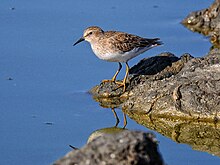Common sandpiper
| Common sandpiper | ||||||||||
|---|---|---|---|---|---|---|---|---|---|---|

Meadow sandpiper in splendid dress |
||||||||||
| Systematics | ||||||||||
|
||||||||||
| Scientific name | ||||||||||
| Calidris minutilla | ||||||||||
| ( Vieillot , 1819) |
The sandpiper ( Calidris minutilla ) is a species from the snipe family . It is the smallest of the Calidris species.
Appearance
The sandpiper reaches a body length of ten to twelve centimeters. The wingspan is 32 to 35 centimeters. The weight varies between 16 and 25 grams.
Meadow sandpipers have a maroon crown in their splendid dress , which is striped in dark brown and white. The cheeks are pale chestnut colored. The breast is also pale chestnut or cream-colored with small, star-shaped spots. The underside of the body is white. The coat is dark brown to black. The feathers on the back are lined with dark chestnut to pale yellow, which makes the dorsal plumage appear clearly scaled. In the plain dress , the head and top of the body of adult birds are brown-gray. The underside of the body is white, with the breast striped brown-gray. The beak is black and pointed slightly downwards at the tip of the beak. The iris is dark brown. The feet and legs are yellow-greenish.
The young birds are feathered in a similar way to adult birds in splendid plumage, but their plumage is overall somewhat more colorful with an intensely chestnut brown and black upper side. The downy cubs have a black and reddish-orange spotted body top with a white body underside.
It can be confused with the sandpiper , which is only slightly larger than the sandpiper. However, he has black legs and feet. The long-toed sandpiper and the pygmy sandpiper are also very similar to the sandpiper.
distribution and habitat
The sandpiper is a Nearctic species. It breeds from western Alaska to Labrador, but is absent in the Canadian Arctic. The sandpiper is very adaptable in the demands on its habitat. It occurs in forests, at the tree line and on the open tundra. It usually lives in swampy areas as well as on shorelines, on beaches and in the alluvial land of the coast. The sandpiper is a migratory bird that overwinters in the southern United States, the Caribbean islands, Central America, and northern South America.
Way of life
The sandpiper mainly eats invertebrates, which it picks up from the ground by pecking and poking.
During the winter months the sandpiper lives sociable, while sandpipers are territorial during the breeding season. The male indicates his territory by climbing steeply into the air. On the ground, the male approaches the female with one or both wings fully or partially raised. Common sandpipers enter into a monogamous relationship that lasts over several breeding seasons. The nest is built in damp places near water. The clutch consists of three to four eggs with brown and cream spots. They are incubated by both parent birds for 19 to 23 days. If a predator approaches the clutch, the breeding bird tries to mislead the potential attacker. The young birds are fledged at an age of twelve to fifteen days and a little later independent of the parent birds. They are sexually mature at the age of one year.
supporting documents
literature
- Richard Sale: A Complete Guide to Arctic Wildlife , published by Christopher Helm, London 2006, ISBN 0-7136-7039-8
Web links
- BirdLife factsheet about the sandpiper
- Calidris minutilla inthe IUCN 2013 Red List of Threatened Species . Listed by: BirdLife International, 2012. Retrieved September 3, 2013.

